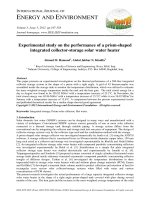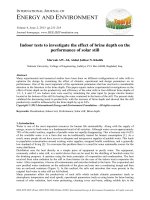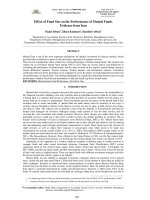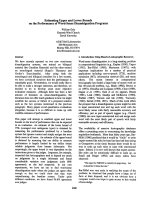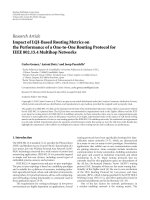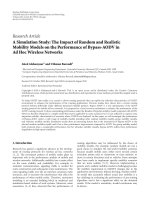Stakeholders perceptions on the performance of motorcycle riding business in nyamagana district
Bạn đang xem bản rút gọn của tài liệu. Xem và tải ngay bản đầy đủ của tài liệu tại đây (260.78 KB, 9 trang )
International Journal of Engineering, Business and Management (IJEBM)
ISSN: 2456-8678
[Vol-6, Issue-2, Mar-Apr, 2022]
Issue DOI: />Article DOI: />
Stakeholders’ Perceptions on the Performance of
Motorcycle Riding Business in Nyamagana District
George Essau, Dr. Tihibunda Ngonzi
Faculty of Business and Economics, St. Augustine University of Tanzania
Email:
Received: 03 Apr 2022; Received in revised form: 18 Apr 2022; Accepted: 22 Apr 2022; Available online: 27 Apr 2022
©2022 The Author(s). Published by AI Publications. This is an open access article under the CC BY license
( />
Abstract— This study sought to examine stakeholder practices in the Nyamagana district motorcycle riding
business. This study used a case study research design with a sample size of 93. In-depth interviews and
questionnaires were utilized to collect data, and SPSS was used to analyze it. The findings indicated activities
such as using various advertising strategies, raising awareness, forming a motorbike driver's association,
offering inexpensive service costs, holding seminars, and safety. The results of correlation analysis revealed
a significant relationship between promotion strategy (r (90) > -.293 p.005), awareness about the use of
motorcycle as a business (r (90) >.154 p048), association of motorcycle drivers (r (90) > -1.12p.295),
affordable price (r (90) >.098p.358), and seminar and safety education (r (90) > -.307 p.003). Motorcycles
are promoted by government authorities as an easy and quick way to get licensed and insured. There were
other concerns including complicated registration, tax compliance, motorcycle driver theft, careless driving,
poor personal cleanliness, inadequate passenger safety gear, and traffic issues. The report advocated clear
mechanisms for motorcycle business operators to undertake their activities without interference by
extraneous authorities, improved working conditions, and regular training and seminars for motorcycle
drivers and operators.
Keywords— Stakeholder’s perceptions, Motorcycle riding business, performance perception,
Transportation, Tanzania.
I.
INTRODUCTION
Motorcycle-based transportation system is not a new
phenomenon in the development of human civilization in
the world (Bailey, 2016). It occupies a critical position in
the transport sector, for both goods, services and people.
This transportation alternative is well known in different
parts of the world. In some places, motorcycle
transportation has been locally named basing on their
operations (Bishop, 2015). The early development of
motorcycle transportation was noticed in England where a
motorcycle taxi began in London city in the early 1950s.
Motorcycle mainly provides a passenger taxi service,
although they can sometimes be hired to move goods from
one place to another (Mabula, 2018).
/>
The rapid development of motorcycle taxis is a good
example of the capacity for innovation which involves
altering the initial use of a transport mode and its adoption
by operators and users (Kumar and Barret, 2008).
Motorized two-wheelers have been appropriate for
commercial activity, the motorbike taxi, in a number of subSharan African cities. The development considerable
growth of cities and continuing importance of central
districts has led to the increase of the daily travel distance
and radial flows. In a difficult economic setting, access to
the city and its enmities (Jobs education, health care
facilities, markets social networks etc.) is essential.
Increasingly such access requires the use of motorized
transport. In some cities the private motorcycle
compensates to a very small degree for the shortage of cars
(Diaz Olvera et al, 2010).
135
George / Stakeholders’ Perceptions on the Performance of Motorcycle Riding Business in Nyamagana District
The growth of motorcycles as a mode of transport in most
parts of sub-Saharan Africa has mostly been driven by the
need to access remote areas with ease in an affordable
manner (Mugie, 2018). Kumar (2018) asserts that a decline
in organized public transport systems has led to rapid
growth in non-conventional means of public transport,
initially provided by minibuses and shared tax or and vans,
and more recently by commercial motorcycles. In East
Africa, the growth and development of motorcycle business
also noticed a huge success in the name Boda-boda transport
service (Singoro, et al 2016) motorcycles business in places
such as in Ugandan history can be traced with the
innovation that has grown from small in the late 1960s at
Busia in the Kenya-Uganda border (Anon, 2014).
Thus, motorcycle business still is one of the most popular
enterprises, which offers employment opportunities to the
youth by which they can generate more income and improve
the quality-of-life motorcycles business offering the basic
mode of transportation in both rural and urban areas
(Luvinga, and Kilasara 2020). Conversely, young people
especially the youth who have completed schooling in many
parts of the country, remain unemployed influencing them
to seek for alternative employment in motorcycle business
as a way of self-employment (Mbegu and Mjema 2019). In
recent decades, the statistics of youth employment in
Motorcycle business is almost doubling every year
(Kavuma, 2015).
The number of motorcycles rises so sharply in Tanzania
since hot discussion conducted in the parliament about
protecting motorcycle operators who engage on motorcycle
business as self-employment Linda, (Poon 2016). The
trends show that the number of registered motorcycles
increases from 308,412 in 2010 to 1,047,659 in 2016 and
also there were over 1,280,000 number of registered
motorcycles in 2018 (Mbegu and Mjema 2019). Growth of
motorcycle taxis in Tanzania was inspired by their success
in neighboring Uganda, where bicycles were first used
(Jamal, 2014). It is not surprising that Tanzania’s
motorcycle taxi is as notorious as the Ugandan ones.
According to the study conducted by Neema (2020) it is
shown that up 2018 there was a rapid increase of motor
cycles over 1,280,000 registered motorcycles and threewheelers which make up 59% (WHO, 2018). Also, the
number of motorcycles and three-wheelers was almost 60%
in 2019 – 2020 and above and it is about to increase more
and in recent years (Neema, 2020).
However, there are challenges such as fundamentally,
substantially allocate and technical claims. Also, there are
technical inefficiencies, and short-term solutions unlike
long terms. Also there are pressure from groups, policy
makers in shaping and re-defining urban transportation
/>
landscapes in an isolated manner. Motorcycle taxi operators
observe no regulations, including simple ones such as
stopping at traffic lights. Many motorcycle taxi riders in
Tanzania don’t have driving licenses, do not wear helmets
and have no qualms about driving in the wrong direction on
one-way roads (Chhron, 2013). Therefore, the origin and
growth of the motorcycle taxis in most African countries
can be traced to the collapse of the bus transport services
either directly provided by the state or contracted for and the
deregulation of the market leading to the growth of informal
operators. The preponderances ubiquity of motorcycle –
taxi- services in Tanzania is clearly manifested in the
proliferation of local names to describe them according
(Kumar 2011). Thus, the study was conducted to assess
stakeholders’ practices with respect to the performance of
motorcycle riding business in Nyamagana district in
Nyamagana district.
II.
LITERATURE REVIEW
This study reviewed both theoretical and empirical
literatures.
2.1 Entrepreneurial orientation Theory
The theory guided this study because it provides the
entrepreneurs has become important stakeholder of the
economic developing of the country thus study the growth
of their business is vital for the purpose of establishing and
dealing with challenges that they encounter in the course of
doing their business hence suggests possible sustainable
solution to foster their growth and development. Therefore,
this theory is relevant to this study because it has helps in
understanding of motorcycle riding business as one of the
entrepreneurial concerns which is growing very fast in
Tanzania hence the need to examine the factors for growth
of the business as well as examining the perception of
different stakeholders towards the performance of this
business.
As conceptualized by Lipkin and Dess (1966), the EO
theory is a subordinate construct with the dimension of risks
taking
innovativeness,
proactiveness,
competitive
aggressiveness and autonomy themselves being construct
that function that function as specific manifestations. This
theory embodies the orientation of an organization towards
new entry and values creation, encapsulating the
entrepreneurial decision, methods and actions of varying
organization actors in order to generate a competitive
advantage. This theory is important because it helps in
creating a strategic approach which considerably promotes
various innovation in the firm. It is also considered as an
important driver to facilitate information relating to
innovation and superior business performance (McGrath,
2001).
136
George / Stakeholders’ Perceptions on the Performance of Motorcycle Riding Business in Nyamagana District
2.2 Empirical Literature Review
Many scholars from the world over have conducted
researches to investigate the stakeholders’ practices with
respect to the performance of motorcycle riding business.
Kores (2017) revealed that considered that simplifies loan
repayment processes that are affordable to motorcycle
owners; additionally, there are some incentives and small
loans that are typically given to them; additionally, on
occasion, the government has waived import duty costs;
additionally, the government has ensured the presence of
effective laws, enacting effective laws to ensure regulation
of mandatory seminars and training for drivers.
Suzy and Gima (2015) found that the primary worry was the
existence of motorcycle rider training. Additionally, it
intended to identify the knowledge gap that would be
addressed by the researcher. This study discovered that
government agencies and their regulatory bodies are often
needed to provide assistance for the execution of the
aforementioned curriculum in order for motorcycle riders to
understand what is expected of them by people to whom
they provide service (passengers). In this study, agencies
such as SUMATRA were included without excluding traffic
cops. They participated in an interview conducted for the
purpose of this study, and training and seminars for service
providers were typically held in Bagamoyo, where they
included drivers, owners, and passengers. As a result, these
seminars and training focused on imparting knowledge and
eliciting feedback from the ministry of transport, as well as
eliciting significant feedback from those who were trained.
In a similar spirit, Tom et al. (2021) stated that the findings
collected indicate that motorcycle use has expanded
significantly in recent years across the African Continent.
The consumers of this transformation referred to it as a tax,
and drivers often charge low rates for transporting
passengers and products between locations. This mode of
transport is more prevalent in rural regions where
transportation is scarce; it is used to deliver services and
also to link people; it is also used by individuals traveling to
farms or market locations.
Angeline and Lubala (2014) discovered in their study that
the growth and development of motorcycle businesses, as
well as the obstacles faced by the community in
implementing the research study, may be accomplished via
collaboration with stakeholders.
According to the research findings, boda-boda drivers often
collaborate and engage with the government at the district
council level and members of the community to encourage
effective involvement and ownership of their enterprise in
order to assure the resolution of income-related concerns.
Turner (2014) asserted that the development of a functional
transportation infrastructure capable of serving the people
/>
in various places in growing economies has created several
chances for small company owners interested in providing
transportation services.
Poon (2016) stated that there are several ongoing arguments
about what appears to be the youth's opinion of motorcycle
taxi company investment and whether the business benefits
investors' well-being, owners, and other stakeholders. That
Taxi assisted several adolescents in entering the taxi
company has been proved in a variety of ways, including
the desire for self-employment, entrepreneurial ideology,
policy operational environment, and public perception of
the taxi sector. As a result, the sector has seen great
development, luring an increasing number of young people
to the field. Additionally, it was discovered in this study that
the study attracted more young participation and had a
positive influence on their economic well-being.
Thus, stakeholders have a favorable image of the
motorcycle taxi industry and its benefits on economic wellbeing, which has resulted in the motorbike firm's increasing
performance.
III.
METHODOLOGY
Mixed research approach was employed in conducting this
research study because it is an approach which always
allows researcher collected data from questionnaire and
interview The study employs case study design for effective
data collection in the field The targeted population of this
study was 1224 people which is made from motorcycle
owners In conducting this research, the researcher
employed a convenient sampling technique which allowed
the selection of the respondents basing on their
convenience. In this study primary data was collected using
questionnaires and interview only. These kinds of data
normally provide information directly associated with the
research problem also they provide real situation of the
research problem by depicting what exists in the field
In this study interview was conducted by the researcher to
prepare an interview guide which contained set of questions
that he/she intended to ask the participants. Also, in this
study the researcher employed a semi structured interview
to collect data. Interview session used at least 30 minutes
for each participant. Data was from interview was recorded
in two ways for example those who agreed to be recorded
the researcher used tape recorder to record the response to
the questions given to them. Questionnaire was effectively
administered by the researcher during the data collection
process whereby the researcher enabled to giver directive
on how the questionnaire was to be filled accordingly. Since
this study employed both qualitative and quantitative
approaches even data analysis was subjected to the analysis
of the qualitative and quantitative data (Bryman, 2006).
137
George / Stakeholders’ Perceptions on the Performance of Motorcycle Riding Business in Nyamagana District
SSE=Seminars and safety education
Quantitative data indicates statistical procedures and how it
was coded and subjected to analysis in form of descriptive
statistics, regression analysis as well as correlations using
Statistical Package for Social Science (SPSS). On the other
hand, qualitative data collected through interviews were
analyzed through thematic procedure of analysis. In
thematic analysis firstly the researcher created initial codes,
then collected the codes which corresponds with supporting
data, also the researcher grouped codes into the themes in
line with the research objectives, which the researcher
narrated the data. The study also adopted a regression
analysis in order to examine the relationship between
research variables under the following regression equation.
LS=Linkage between motorcycle business and another
sector
IV.
RESULTS AND DISCUSSION
4.1 Data Analysis and Presentation
The researcher collected data by using questionnaires and
interview from 93 participants however 90 filled
questionnaires while 3 participants were interviewed. Data
analysis, presentation and discussion was guided by
objective of examining stakeholder’s perception with
respect to the performance of motorcycle riding business in
Nyamagana district. Thus, for this reason the respondents
were asked several questions in relation to this aspect in
relation to promotion strategy, awareness about the use of
motorcycle as business, association of motorcycle drivers,
affordable price, and seminar and safety education.
y = 1𝑋1 + 2𝑋2 + 3𝑋3 + 4𝑋4 + ⋯ eq 1
y = 1AMD + 2𝑋AP + 3AU + 4LS + 5PS +
6SSE + ⋯eq 2
Whereby
Y=dependent variable
. By using the Likert scale provided the respondents had to
determine the level of their argument whereby in their
response they were required to put a tick in suggesting on
whether they 5 = strongly agreed, 4 = agreed, 3 = Neutral, 2
= disagreed and 1 = Strongly Disagreed. The results
obtained in this aspect was summarized and presented in
Table 1 as follows.
=Beta
PS=Promotion strategies
AU=Awareness about the use
AMD=Association of motorcycle drivers
AP=Affordable prices
Table 1 Stakeholders Practices with Respect to Performance of Motorcycle Riding Business.
Stakeholders Practices with Respect to
Performance of Motorcycle Riding Business.
1
2
3
4
5
F (%)
F (%)
F (%)
F (%)
F (%)
The use of different promotion strategies
34(37.8)
36(40.0)
1(1.1)
15(16.7)
4(4.4)
Creation of awareness about the use
motorcycles
18(20.0)
39(43.3)
21(23.3)
9(10.0)
3(3.3)
Formation of association of motorcycle drivers
41(45.6)
32(35.6)
0
10(11.1)
7(7.8)
Provision of affordable prices for the service
use
30(33.3)
46(51.1)
11(12.2)
0
3(3.3)
Provision of seminars and safety education to
drivers
43(47.8)
32(35.6)
0
0
15(16.7)
Linkage between motorcycle riding business
and other sector
32(35.6)
32(35.6)
10(11.1)
0
11(12.2)
Source; Field Data (2021)
4.2 Results of Correlation between the perception of the
stakeholders on the performance of Motorcycle Riding
Business
The analysis of correlation was performed in order to
examine the relationship of the research variables. The
/>
focus of this study is examining the relationship between
stakeholder’s perception and performance of motorcycle
riding business. Pearson correlation analysis was conducted
to verify the existence of the relationship between
independent and the dependent variables. After preforming
138
George / Stakeholders’ Perceptions on the Performance of Motorcycle Riding Business in Nyamagana District
the correlation tests the results obtained were summarized
and presented in Table 4.10 as follows herein below.
Table 2 Pearson Correlation Matrix
PS
PS
Pearson Correlation
AU
AMD
AP
SSE
LS
1
Sig. (2-tailed)
N
AU
Pearson Correlation
.154
Sig. (2-tailed)
.048
N
AMD
90
Pearson Correlation
-.112
.121
Sig. (2-tailed)
.295
.257
90
90
90
Pearson Correlation
.098
.050
-.243*
Sig. (2-tailed)
.358
.639
.021
90
90
90
90
-.307**
-.124
.220*
.212*
.003
.244
.037
.045
90
90
90
90
90
Pearson Correlation
.190
-.293**
-.157
.359**
.212*
Sig. (2-tailed)
.003
.005
.138
.001
.045
90
90
90
90
90
N
SSE
Pearson Correlation
Sig. (2-tailed)
N
LS
1
90
N
AP
90
N
1
1
1
1
90
**. Correlation is significant at the 0.01 level (2-tailed).
Source; Field Data (2021)
The abbreviations on the table above defined as follows
AMD=Association of motorcycle drivers
AP=Affordable prices
AU=Awareness about the use
LS=Linkage between motorcycle business and another sector
PS=Promotion strategies
SSE=Seminars and safety education
From the correlation analysis, there is a significant
relationship of promotion strategy on the performance of
motorcycle riding business (r (90) >-.293 p>.005) this can
be interpreted that there is a positive relationship between
promotional strategy and performance of motorcycle riding
business. Awareness about the use of motorcycle as
business (r (90)> .154 p<048), which means there is a
relationship between awareness and performance of
motorcycle riding business. Also, association of motorcycle
drivers (r (90)> -1.12p<.295), this also shows that there is a
/>
relationship between research variables. On the other hand,
affordable price (r(90)>.098p<.358), which also shows that
relationship between research variables. On the other hand,
seminar and safety education (r (90)> -.307 p< .003) which
also means that there is a relationship between provision of
seminars and safety education on the performance of
motorcycle riding business. Lastly Linkage with other
sectors had a (r (90)> .190 p<.003). From the results
obtained it can be established that there is a relationship
139
George / Stakeholders’ Perceptions on the Performance of Motorcycle Riding Business in Nyamagana District
between the independent variables and the dependent
variable
charging a fare to carry passengers or goods. The local
people can have accesses to services and farms to markets,
hence leading to the growth in recently (Tom et al 2021).
Bailey, (2016). Also motorcycles driver association
occupies a critical position in the transport sector, for both
goods, services and people as well as give better position in
offering transportation throughout the city because they
were easily accessible and they could get through traffic
congestions without wasting time (Martinez, 2011).
The findings presented in this aspect supports the results
that because of creating awareness to the customer has
helped customer to have good perception about Motorcycle
riding business in relation to safety, security as well as
honesty of their drivers when providing services (Suzy and
Gina (2015). The use of motorcycles has increased greatly
in recent years, they are often used as taxis, with riders
Table 3 Coefficients a
Model
Unstandardized Coefficients
B
Std. Error
(Constant)
3.012
.399
AMD
.022
.086
AP
.003
AU
Standardized
Coefficients
t
sig.
Beta
7.547
.000
.025
.255
.000
.073
.004
.042
.003
.007
.102
.006
.066
.001
LS
.287
.138
.215
2.085
.004
PS
.175
.100
.176
1.748
.005
SSE
.363
.091
.407
.365
.002
Source; Field Data (2021)
The abbreviations on the table above defined as follows
AMD=Association of motorcycle drivers
AP=Affordable prices
AU=Awareness about the use
LS=Linkage between motorcycle business and another sector
PS=Promotion strategies
SSE=Seminars and safety education
Table 3. shows that promotional strategy has a strongly
shows a strong and significant relations on the performance
of the motorcycle riding business (β= .025, p = 000), in
addition awareness about the use also has sternly positive
significance relationship (β=004. P= .000). Also,
association of motorcycle drivers (β=0.06, P= .001) which
means there is a strong significant relationship between
association of motorcycle drivers and performance of
motorcycle riding business.
On the other hand, affordable prices (β=.215, P= .004),
which also shows positive significant relationship between
the variables. Not only that but also there are seminar and
safety education which shows a relationship (β=.176,
P=.005) and lastly linkage between motorcycle riding
business and other sectors has a relationship with the
performance of motorcycle riding business (β= .407, P=
/>
.002). Thus, it can be observed that from other researchers
that the application of the boda-boda taxis for the
commercial uses have contributed largely to the economic
growth and development of the society. The challenges
which face this kind of business operation are in the
regulation of the activities to ensure that they have
maximum contribution to the society’s well-being (Oladipo,
2012). However, the working situation have effects of the
health of the drivers because they pose riskier situation due
to accidents which occurs on the roads. Therefore, it
recommended that there is a need to change the perception
of the people toward this business in order to improve
provision of basic and improved services. Also, it was
recommended that some measure have to be taken make
motorcycle business professional like other business
(Loudes et al 2019).
140
George / Stakeholders’ Perceptions on the Performance of Motorcycle Riding Business in Nyamagana District
Table 4. ANOVA a
Model
1
Sum of Squares
df
Mean
Square
F
Sig.
Regression
21.936
6
3.656
7.711
.000b
Residual
39.353
83
.474
Total
61.289
90
Source; Field Data (2021)
riding business in different parts of the country because of
From the Anova test, it was revealed that mean square was
its simplicity in the start-up process. Thus, there is
.3656 regression values and the F values was 7.711, but the
importance of more research to be conducted on the
p=value was .000 which means that there is a positive
understanding of appropriate ways to effectively regulate
significant relationship between the stakeholders’
motorcycle operators for the improved safety and ensuring
perception and the performance of motorcycle riding
the benefit of improved access are shared by all rural people.
business. Therefore, to this effective the relationship
In the same vein Yong Zhang (2017) sensibility analysis or
between research variable since the tests of cognizance was
not only the company’s order volatility, revenues growth
.000 which is below 0.005 hence there is positive significant
and utilization of resource, but also influence on citizen’s
relationship between stakeholder’s perception and
welfare, energy consumption and environment pollution
performance of the motorcycle riding business. Also,
which enable practical regulation and policies within taxi
according to Starkey (2016) operation of many motorcycles
industry.
is without provision of drivers training services. Hence there
is a considerable improved performance of motorcycle
Table 5 Model Summaryb
Model
1
R
.598a
R Square
.358
Adjusted R Square
.311
Std. Error of the
Estimate
.289
Durbin-Watson
2.321
Source; Field Data (2021)
This test shows presence of an autocorrelation which exists
among the variables as Durbin Watson coefficient was
within the acceptable range of 2.321. According to Field
(2009), Durbin-Watson coefficient below 1.5 or above 2.5
may raise a concern.
V.
CONCLUSSION AND RECOMMENDATIONS
In this objective the researcher aimed to examine the
perception of the different stakeholder on the practices
ensured performance of motorcycle riding business in
Nyamagana district. Motorcycle riding business has been a
fastest growing business in this district. Basing on the
findings obtained in relation to the awareness about the
strategies used to enhance performance of motorcycle riding
business. This study revealed that an understanding and
awareness among motorcycle owners, driver. They
generally perceived to enhance performance of their
business, there are different acts which are done which
/>
amounts to enhance performance. The use of different
promotion strategies, creation of awareness about the use
motorcycles, formation of association of motorcycle
drivers, provision of affordable prices for the service use,
provision of seminars and safety education to drivers and
linkage between motorcycle riding business and other
sector.
Also, it was revealed that since motorcycle business is like
other businesses therefore, to create awareness to the people
by promoting our business is something very important.
There are different strategies which can be used to enhance
performance of motorcycle riding business, though these
are not formal strategies but they are the one that we use in
creating awareness to our customers about our services.
Thus, it was revealed from the findings obtained that the
perceptions of different stakeholders have contributed
highly to the performance of motorcycle riding business in
the study area. This is because different stakeholder
141
George / Stakeholders’ Perceptions on the Performance of Motorcycle Riding Business in Nyamagana District
provided positive consideration whenever they were asked
about business. Also, they had good and positive
commentaries which they put forward upon the use of this
service for transport of goods and people performance place
to another within the study areas or another area.
[6]
[7]
Based on the findings of this study, the following
recommendations are hereby presented:
i.
ii.
iii.
iv.
This study recommends that the local government
authorities as one of the development stakeholders,
should develop clear mechanism in order to enable
motorcycle riding business operators to conduct
their activities in a conducive environment and
without any disturbances from irrelevant
authorities.
The study also recommends that local government
authorities should improve working environment
by improving roads and other facilities which
facilitates the improvements of business riding
performance for motorcycle business.
The study also recommends regular trainings and
seminars for the youth motorcycle drivers and
operators so as to know their values and put
forward major consideration such as maintaining
health and occupational safety guidance which is
provided during training and seminars.
Also, the study recommends that proper measure
should be taken by the operators to report any act
of corruption which might happen when they
conducting their business
The study recommends another research study to be
conducted on the factors affecting customer choice of
using motorcycle riding business as a means of
transport in the intra - city travels
REFERENCES
[1] Ajay, K. (2011). Understanding the emerging role of
motorcycles in African cities. A political economy
perspective SSATP Discussion Paper No. 13 Urban
Transport Series.
[2] Anne, H. O., Edward M., Stephen M., Linda H., and Alison
G., A. (2015). Youth unemployment, community violence,
creating opportunities in Dar es Salaam, Tanzania: A
qualitative study. Tanzania Journal of Health Research
17(1).
[3] Anon, H. I. (2014). Motorcycle related road traffic crashes in
Kenya facts & figures. RS10, Kenya project, Nairobi
[4] Anon, H. I. (2015). Rural transport service indicators; report
of the piton-Djallo road, Nothern Cameroun. International
Forum for Rural Transport and Development. London
[5] Bailey, O. (2016). Emerging mobility crisis: The use of
motorbike as public transport in cities, communication at the
/>
[8]
[9]
[10]
[11]
[12]
[13]
[14]
[15]
[16]
[17]
[18]
[19]
[20]
[21]
10th World Conference of Transport Research, Seoul. Sage
publications: United States. 28-31pp.
Bartlett, J. (2013). Motorcycle reliability survey shows what
goes wrong. Consumer Reports, retrieved 26 March 2013
Bello, H., & Jatum, A., & Inuwa, N. (2017). An appraisal of
socio-economic impacts of commercial motorcycles in
Gombe State, Nigeria. International Journal of Asian Social
Science. 7(6) 480-488.
Berrones, S., & Luis, D. (2018). The working conditions of
motorcycle taxi drivers in Tláhuac, Mexico City. Journal of
Transport & Health. 8: 73–80.
Bishop, T. (2015). Opportunities to improve road safety
through Bodaboda associations in Tanzania. Africa
community access partnership. Dar es Salaam. Thrust
Publication Ltd: 38-42pp
Boniface, M., M. (2011). Critical success factors in the
Motorcycle Bodaboda Business in Nairobi, Kenya. Master of
Business Administration Degree, School of Business,
University of Nairobi. (Unpublished).
Bryman, A. (2006). Integrating quantitative and qualitative
research: How is it done? Qualitative Research 6(1):97–113
Creswell, J. (2012). Educational research: Planning,
conducting, and evaluating quantitative and qualitative
research (4th ed.) Upper Saddle River, NJ: Pearson
Education.
Duglin K., S. (2005). The savvy guide to Motorcycles, Indy
Tech Publishing,
Emilie, M. (2020). Taking a sustainability turn? Stakeholder
perceptions on electrification of motorcycle taxis in Nairobi,
Kenya. Master of Science in Urban Management at
Technische Universität Berlin (Unpublished)
Euphracia, A., O. (2019). The contribution of motorcycle
business to the wellbeing of operators in Kisumu County,
Kenya. Master of Arts degree in community development of
Kenyatta University (Unpublished).
Galuszka, J., & Martin, E., & Nkurunziza, A., &Achieng’ O,
J. & Senyagwa, J., & Teko, E. Lah, O. (2021). East Africa’s
policy and stakeholder integration of informal operators in
electric mobility transitions Kigali, Nairobi, Kisumu and Dar
es Salaam. Sustainability 13, PP 17 – 30.
Gitonga, V., W. (2014). Factors influencing growth of
informal transport sector: A case of Bodaboda transport in
central division, Embu west district. Masters of Arts degree
in project planning and management. University of Nairobi
(Unpublished).
Jamal, V. (2014). Farewell to farms: De-agrarianisation and
employment in Africa. Aldershot: Ashgate. 12pp
James, J., N. and James, G., K. (2019). The influence of
motorcycles/bodaboda on community development in rural
Kenya: A study of the challenges facing motor cycle
operators in Meru South Sub-County. Journal of Education
and Human Development March (8)1, pp. 86-92.
Kavuma, R. (2015). Revved and ready to go: Tanzania is set
to tackle unstoppable Bodaboda taxis. The Guardian.
Guardian News and Media Limited.
Kombo, D. K. & Tromp, L.A. (2006). Proposal and thesis
writing: An introduction. Nairobi: Pauline Publications
Africa.
142
George / Stakeholders’ Perceptions on the Performance of Motorcycle Riding Business in Nyamagana District
[22] Kores, T. M. (2017). Factors determining growth of
motorcycle transport in Kajiado County, Kenya. Master of
business administration (corporate management) to the
school of business and public management of KCA
University (Unpublished).
[23] Kothari, C. (2007). Research methodology; methods and
techniques. New age international (P) Limited. New Delhi.
[24] Krishnaswani, O. R. (2003). Methodology of research in
Social Sciences, Himalaya Publishing House, New Delhi,
India.
[25] Kumar, R. (2011). Research methodology: A step-by-step
guide for beginners, (3rdEd). New Delhi: Sage publication
Inc.
[26] Lin, J., & Xin L., and Yaqian L. (2018). Impact of different
stakeholders of bike-sharing industry on users’ intention of
civilized use of bike-sharing 10 (1437) pp. 1 26
[27] Lourdes, D., & Olvera, A., G. & Didier, P., & Pascal P.
(2016). Earning a living, but at what price? Being a
motorcycle taxi driver in a Sub-Saharan African city. Journal
of Transport Geography, Elsevier, 55, pp.165 - 174.
[28] Luvinga, K., & Kilasara, S. (2020). The financial
implications of Bodaboda transport business among youths
in Arusha- cost benefit analysis. Advances in Social
Sciences Research Journal, 7(4), 177-185.
[29] Mbegu, S. & Mjema, J. (2019). Poverty cycle with
motorcycle Taxis (Boda-Boda) Business in Developing
Countries: Evidence from Mbeya Tanzania. Open Access
Library Journal, (6) 1-11.
[30] Neema, U. (2020). Contribution of Bodaboda business on
improving the standard of living among youth in Tanzania: A
case of Ubungo district in Dar es Salaam. Master of Business
Administration in Corporate Management (MBACM) of
Mzumbe University, (Unpublished).
[31] Nicola, B., (2016). Youth poverty, employment and
livelihoods: Social and economic implications of living with
insecurity in Arusha, Tanzania. International Journal of
Environment and Urbanization.28 (2), page(s): 437-45
[32] Oladipo O., O. (2012). The development and impact of
motorcycles as means of commercial transportation in
Nigeria. Research on Humanities and Social Sciences. 2(6)
231 – 239.
[33] Olawo, K. W., & Ochieng. I., & Ombok, O., & Benjamin, A.,
& Florence O., (2014). The effect of increased investment in
Bodaboda business on economic empowerment of people in
Kisumu west district. European Journal of Business and
Management 6 (39).
[34] Poon, L. (2016). The love-hate relationship between East
Africa and its two-wheeled taxis. City Lab. The Atlantic.
[35] Rachel, A., Tom, W., & Robin, L., & James., W. (2019).
Barriers to investing in cycling: Stakeholder views from
England. Transportation Research Part A: Policy and
Practice 12(8) pp 149-159
[36] Singoro, B. W., Wakhungu, J., Obiri, J., & Were, E. (2016).
Causes and trends of public transport motorcycle accidents in
Bungoma County, Kenya. International Journal of
Multidisciplinary Academic Research, 4(1), 36– 42.
[37] Sithembiso, M., & Richard, M. (2019). Motorcycle parts and
aftermarket industry regional value chain in Southern Africa.
/>
[38]
[39]
[40]
[41]
United Nations World Institute for development economic
Research. WIDER Working Paper 2019/38
Suzy, C., and Gina, P. (2015). Tanzania motorcycle taxi rider
training: Assessment and development of appropriate
training curriculum final report. AFCAP Project Reference
Number:
TAN2015E
available
from
retrieved on 29th April 2021.
Tom, B., and Caroline, B., (2021) Enhancing understanding
on safe motorcycle and three-wheeler use for rural transport.
Literature review. Available from
retrieved on 27th April 2021
Turner J., Mgonja E., Barber C., & Brader H., (2018). An
investigation into the role of transport operator associations
in shaping transport services in Africa’s rural areas.
Transaid, London, UK. 144p
Zoé J. Bosch, Dirk R., (2021). Strategic positioning of a
motorcycle manufacturer within the Fourth Industrial
Revolution. Independent research journal in the management
science. 21(1) pp 23 – 41.
143
